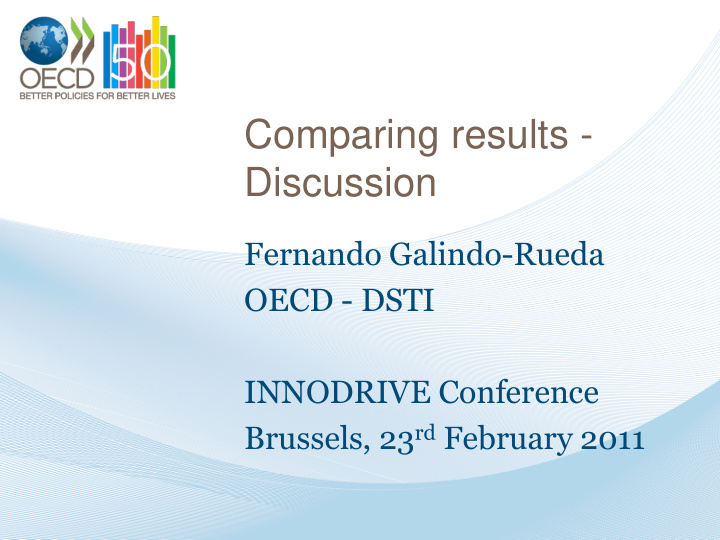



Comparing results - Discussion Fernando Galindo-Rueda OECD - DSTI INNODRIVE Conference Brussels, 23 rd February 2011
My past and current interests • 2007 Satellite R&D account for the UK • OECD TF: Handbook on Intellectual Assets • Work on intangibles, e.g. engineering design • […] Career gap advising UK HMG on industrial policy […] • At OECD since Oct 2010. Responsible for Working Party of National Experts on Science Technology Indicators (NESTI) --- innovation focus. • Project on mechanisms for knowledge exchange: (KNM)
Assessing the intangibles “project” Lost? Bumpy ride On track? Mission ahead? accomplished ? Innovative property Quality of computerised information Economic competencies -Brand strength -Organisational capital What vision for impacts?
Achievements • Intangibles here to stay – INNODRIVE and COINVEST great contributions (e.g): – Widened reach of CHS exercise. – New exercises to answer key measurement questions: e.g. intang. survey, deprec. – Econometrics brought in to test growth accounting and expand questions – Systematic use of occupation data – Micro focus – relate inputs to outputs and company value
Discipline or (cottage) industry • Macro accounting – taking disciplines seriously? – Appropriate language? Cause? Circularity? – Appropriate use of terms: “investment” • Production/investment/supply/use • Own account • Rest of the world? Other sectors? Regions? – Use standards out there. OECD Handbook IA – The trinity: scope, deflation, depreciation
The framework • How to get closer to growth and innovation disciplines? – How does IA acct work with innovation as we know it? – An example: R&D in the A-H model. – Implications • Positive 1: Better quality description • Negative: Still mis-attributing sources of growth. Externalities. (+ve and -ve) • Positive 2: A research agenda in front of us • Positive 3: A perspective on material wellbeing • But cause for reflection…
Intangibles and sustainable growth • Focus on adjusted NDP: – Expanded GDP, but also need to expand depreciation / obsolescence. • New NDP=Traditional GDP – tang K dep + + Gross int. invest- intangible obsolescence • Higher rate of innovation increases depreciation of knowledge. – Caution about increasing importance of intangibles. Gross versus net. – Caution about the implications regarding prosperity.
Think harder about framework and its full implications • National Accounts: A framework that endorses double counting • Bringing in idea-making idea machines – very hard to conceptualise and operationalise • Where is the “free cash flow of the aggregate economy”? The future consumption to offset CHS foregone consumption. Not adjusted GVA • From micro to macro assets - mutual obsolescence.
Relevant future NESTI work • Task Force on Business R&D and innovation survey re-design: – Cognitive testing metastudy – Expenditures questions: intangibles approach – Implementation of R&D capitalisation – Focus on design – Oslo Manual • Intangibles measurement for NSG – with OECD STD and WPIA • Public support for innovation • FTEs for research - ?? Other innov.
Open research questions • Other key research issues – Knowledge workers – Intangibles flows. • Policy issues – Balance of externalities from intangibles (+,-) – Market failures regarding information • Intangibles policy evaluation – Tax incentives – Other…
Thank you!! Your turn…
Assessing the intangibles “project” Lost? Bumpy ride On track? Mission ahead? accomplished ? Innovative X property Quality of X computerised information Economic competencies -Brand strength X - Risks -Organisational X capital What vision for impacts?
Recommend
More recommend